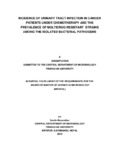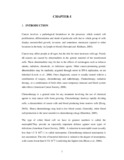Please use this identifier to cite or link to this item:
https://elibrary.tucl.edu.np/handle/123456789/637| Title: | Incidence of Urinary Tract Infection in cancerpatients Underchemotherapyand the Prevalence of Multidrug Resistants trains among The isolated Bacterial Pathogens |
| Authors: | Manandhar, Sunila |
| Keywords: | chemotherapy;cancer;UTI |
| Issue Date: | 2010 |
| Publisher: | Central Department of Microbiology |
| Institute Name: | Central Department of Microbiology |
| Level: | Masters |
| Abstract: | Cancer and its treatment causes both direct and indirect effect on a patient's immunesystem which increases the susceptibility of immunosuppressed cancer patients toinfections.UTI is the common bacterial infectiongenerally detected in cancer patientsspecially in those who are on chemotherapy. UTI in cancer patients should beconsidered complicated when it occurs asa result of suppressed immunity. This study was conducted in OMHospital and Research Center, Kathmandu amongcancer patients underchemotherapy fromFebruary2009 toJuly 2009.The aim of thisstudy was to investigate the incidence of UTI in these patients, establish an antibioticsusceptibility profile of the isolated organisms and determine the prevalence of MDRstrains.This study was also carried out with anobjective to find the possibleassociationbetween the blood cell count and occurrence of UTIamong these patients. Altogether, 127 mid-stream urine samples from cancer patients under chemotherapywere investigated by conventional semi-quantitative culture technique, pus cell count,and albumin test for detection of UTI. Meanwhileblood samples were also collectedfrom all the patients to determine their totalWBCcount and absolute neutrophil count. Out of 127 urine samples, 26 (20.5%) samples showed significant bacterial growth.Status ofsignificantbacteriuria was found higher in females(65.4%) than in males(34.6%).However, association between significant bacteriuria and gender of the patients was found tobe statistically insignificant (P>0.05).The highest number of growth positive samplesbelonged to the age group 70-80(38.5%).Maximumoccurrenceof UTI (n=13,50%)were found in thosepatients who had received 6-8 chemotherapy cycles followed bythose who had received 4-6 cycles (n=10,38.5%). No significant association was foundbetween the total WBC count and the occurrence of UTI (P>0.05).Similarly, nosignificantassociationcould be established betweenUTIand theconditionwhenANC<1500(P>0.05). Out of the 26 bacterial isolates, 25 were gram negatives and the remaining one isolatewas a gram positivecocci.Escherichia coli was found to be themost predominantisolate (73%). Other bacterial isolates which were found in the study wereCitrobacterfruendii (7.7%), Klebsiella oxytoca (7.7%), P. aeruginosa(3.9%), Acinetobacterspp.(3.9%) andS.aureus(3.9%). Among theGram negative organisms, Amikacin was found to be the most effectiveantibioticfollowed by Ceftazidime and Nitrofurantoin.Fluoroquinolones were found tobe highly resistant towards the majority of gram negative isolates. The only isolate ofS.aureuswas found susceptibletowards Amikacin and Novobiocin. Multidrug resistance (MDR) was observed in88.5% (23/26)of the total bacterial isolates.Among the19E. coli isolates, 16 (84.2%) were MDR-strains.All the other batcerialisolates were alsofound to bemulti-drug resistant. Key words: UTI, cancer, chemotherapy, MDR, Total WBC count and ANC |
| URI: | http://elibrary.tucl.edu.np/handle/123456789/637 |
| Appears in Collections: | Microbiology |
Files in This Item:
| File | Description | Size | Format | |
|---|---|---|---|---|
| COVER.pdf | 47.1 kB | Adobe PDF |  View/Open | |
| CHAPTER.pdf | 346.16 kB | Adobe PDF |  View/Open |
Items in DSpace are protected by copyright, with all rights reserved, unless otherwise indicated.
